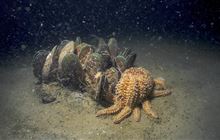Priorities for marine sediment research
Introduction
The most important research to address sediment and its negative effects on the marine environment were identified in a report.Download the report
Steering our waka through turbid waters: Research priorities over the next 5 years for sediments in the coastal marine area of Aotearoa New Zealand. (PDF 1,460K)
Green, M.O., Walker, J. and Nicol, S., 2021.
About the report
DOC commissioned the report to identify research priorities to address marine sediment for 2021–2026, using the tools in the Resource Management Act. (At the time of writing, the Act was in place but a replacement had been announced.)
Input to the report was gathered from more than 100 participants including management agencies, councils, universities, non-governmental organisations, businesses, Crown research institutes, scientists and Māori researchers. A combination of desktop research and interviews was used.
The focus is on the effects of sediment in the coastal marine area to 12 nautical miles offshore. The effects can include disturbance of natural sediments by seabed mining or dredging.
Two fundamental concepts – mātauranga Māori (traditional Māori knowledge) and climate change – are woven throughout the document
While this report focussed on the marine environment, a mountains-to-sea approach is noted as being essential to make progress with this complex issue. Many people, and local and national government agencies are involved in sediment reduction work.
Recommendations for priority research
These recommendations were reported as being likely to have the greatest impact on improving marine sediment for 2021–2026.
Identify sources of sediment
Develop tools to identify where the sediment is coming from at the scale of individual activities and areas of land.
Motivate people
Find out why no apparent progress is being made despite the information and tools that are available. Develop ways to understand and change people’s behaviours, which may include using incentives.
Understand success
Define the minimum necessary environmental conditions that must be met for a restoration to be counted as a success.
Limits-based management
Investigate if the limits set in the National Policy Statement for Freshwater Management are appropriate as targets for marine sediment. Develop simple methods for calculating sediment load limits into plan rules, which take account of legacy effects.
Develop models
Integrated physical–ecological–economic catchment-scale models should be developed. The models should be based on new ecological knowledge and cost-benefit analyses that incorporate non-market valuations of ecosystem goods and services.
How to use the research priorities report
The research opportunities identified in this report can be investigated by any researcher, institution or agency – marine sediment is a complex issue and contributions from all sectors are required to fix it. It is hoped that the report will act as a central point of information to guide future conversations and direction in this important area.
Central and local government agencies may use the research report to prioritise marine sediment research. DOC will also use it to help set priorities for research and management.


